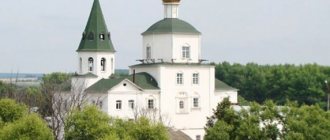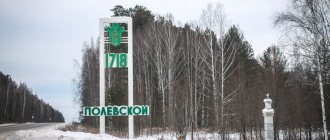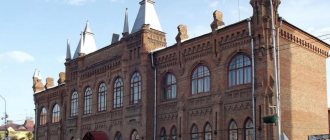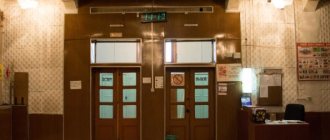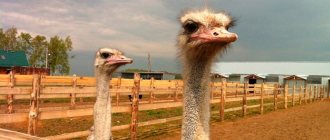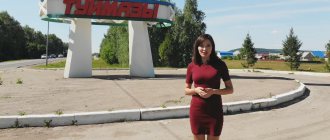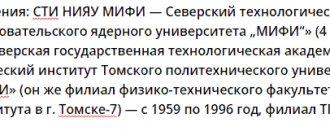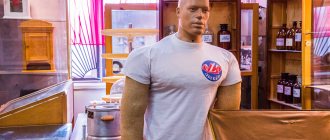History of Kyshtym
This settlement arose as a mining settlement at the Upper and Lower Kyshtym ironworks on the Kyshtymka River, founded by Nikita Nikitich Demidov on lands purchased from the Bashkirs. The founding date is considered to be 1757 , when the first products were received.
It is believed that the name came from Bashkir words meaning “winter camp” or “quiet winter hut” . According to another version, peoples who paid tribute to another people were called Kyshtyms in Tatar (this was pointed out by the historian G.F. Miller in the 18th century). Kyshtym residents adhere to the first option.
During the Peasant War in 1774, the Kyshtym factories were captured by Pugachev’s associates, burned and looted. Later the factories were restored.
In 1809 P.G. Demidov sold the Kyshtym factories to the Yekaterinburg merchant L.I. Rastorguev . In 1822-23, the largest workers' uprising in the 19th century took place in the Kyshtym mountain district, caused by deteriorating living conditions, non-payment of wages and food shortages.
Since 1823, the factories were managed by Grigory Zotov the “Kyshtym Beast” for his cruelty . Rumors about Zotov’s arbitrariness reached St. Petersburg. Count A.G., who came to investigate Stroganov ordered the factory pond to be lowered, at the bottom of which a terrible discovery awaited - the remains of murdered workers. G.F. Zotova and P.Ya. Kharitonov was put on trial. The proceedings went on for ten years, and in 1837 they were exiled for life to the Finnish city of Köksholm. The further fate of Zotov and Kharitonov is unknown. Now they are increasingly talking about Zotov as a talented manager, forgetting what human sacrifices this was achieved...
Kyshtym belonged to the Yekaterinburg district of the Perm province. In the first half of the 19th century, it became the center of the Kyshtym mountain district , which, in addition to the Kyshtym factories, included the Kaslinsky, Nyazepetrovsky, Shemakha and Techensky plants, as well as mines and gold mines.
In 1896, a railway , connecting Yekaterinburg and Chelyabinsk. Before this, the metal was sent by water in barges from the Nyazepetrovskaya and Sorokinskaya piers on the Ufa River.
In 1900, the mining district was corporatized. In 1907, the Kyshtym Mining Plants Society was taken over by the Englishman Leslie Urquhart . His deputy was Herbert Hoover , the future 31st President of the United States.
During the Civil War in July 1919, there were battles here, as a result of which the Kyshtym factories were liberated from the Whites by units of the Red 35th Infantry Division.
In May 1921, a terrible fire broke out in Kyshtym, destroying about a third of the city - about 700 houses burned down. The chairman of the Central Election Commission himself, the “all-union headman” M.I., Kalinin , who specially came to Kyshtym.
Kyshtym received city status in 1934. The main industrial enterprises: copper-electrolyte, abrasive, refractory, electromechanical plants, machine-building association, radio plant, kaolin plant, Russian Quartz, knitwear factory and others.
At the beginning of the 20th century, the Kyshtym Copper Electrolyte Plant began producing refined copper . Later, in 1928, the first batch of Soviet selenium , and in 1932, tellurium . By the way, Kyshtym selenium was also used to make ruby glass for the new stars of the Moscow Kremlin . Originally in 1935 they were made of high-alloy steel and red copper with precious Ural gems, but a year later the stars faded. Then, in 1937, they were replaced by new luminous ruby stars, and Kyshtym selenium gave them a rich bright red color. And at another enterprise, the Kyshtym Mechanical Plant, in 1934, among other things, they began production of the first domestic rotary hammers .
In the mid-20th century, as part of the Atomic Project, the Mayak plant and the closed city of Ozyorsk were built nearby. On September 29, 1957, a serious radiation accident occurred there. An explosion occurred at a liquid waste storage facility, causing a radioactive cloud to rise into the air and cover a large area. An extensive East Ural radioactive trace (EURT) was formed, and many villages had to be relocated after this. The radiation disaster was kept secret, officially confirmed only in 1989. According to the nearest “open” city, it was called the Kyshtym accident , although Kyshtym has nothing to do with it.
The Kyshtymite rock is named after the city . The population of Kyshtym is 36 thousand people.
Sights of Kyshtym
Since the city began with two factories, it is still divided into Upper Kyshtym and Lower Kyshtym. The most interesting is Upper, especially its historical center.
The main attraction of the city of Kyshtym and its calling card is the so-called White House - the estate of the factory owner (Karl Marx St., 2). The high importance of the White House for the city is clearly evidenced by the fact that it appears on its coat of arms (along with the Sugomak and Egoza mountains).
Construction of the estate began by Demidov along with the construction of the Verkhne-Kyshtym ironworks in the 1750s. The architect is unknown, but there is an assumption that the author of the project was the famous architect Matvey Kazakov. At first it was a two-story manor in the Baroque style.
In the first half of the 19th century, by order of the new owner, L.I. Rastorguev, the building was reconstructed according to the design of the talented Yekaterinburg architect M.P. Malakhova. Reconstruction was completed already under G.F. Zotov. After this, the external appearance of the building began to resemble the Rastorguev-Kharitonov estate in Yekaterinburg.
The building in the classicist style has three floors, decorated with large columns, reminiscent of a palace. They called him White for his whitewash. It housed the Main Directorate of the Kyshtym Mining District. The factory owner stayed here during his visits, the families of managers, government officials, the chief forester, and servants lived here. Famous people who visited the Kyshtym factories also visited here. Among them was the famous chemist D.I. Mendeleev in 1899.
During Soviet times, the White House was occupied by a vocational school, a nursing school, and a pedagogical institute named after Leningrad, evacuated from Leningrad. Herzen, the House of Pioneers, a children's library, and later it was transferred to the local history museum.
The White House is a federal cultural heritage site. In 2000, renovation and restoration work on the White House began. They walk extremely slowly, the condition of the building is still very sad. We can only hope that someday the restoration, which has lasted for several decades, will end, and the building will again become the pride of the city and will delight people.
For the period of restoration, the Kyshtym Historical and Revolutionary Museum is located at st. Metallurgov, 2 (tel. (35151) 4-12-55). By the way, the museum in the White House arose at the end of the 19th century, when the manager of the Kyshtym mountain district P.M. Karpinsky collected a collection of artistic castings and mineral samples here. After the revolution, part of the casting was exported abroad, and after the fire of 1921, the rest was transferred to the Sverdlovsk Museum of Local Lore. In the 1970s, the museum was created virtually anew, on a voluntary basis.
In addition to the main house, the architectural ensemble of the factory owner's estate also includes two outbuildings with towers, a park, and a fence with a gate. Particularly interesting are the wings , above which rise massive octagonal watchtowers with high hipped roofs. In one of the wings there was a factory office, and in the other there was a stable. Resembling formidable fortress towers, they were quite suitable for defense if necessary. They were topped with spiers, which previously had metal weather vanes depicting camels - symbols of trade. Now the towers are abandoned.
underground passages leading from the towers . We once got into one of them. This passage connected two wings. The walls are made of wild stone. In Soviet times, the passage was adapted for communications, and pipes were laid here. Surely similar moves were made towards the White House. Somewhere here there was a prison and a torture chamber, in which, according to legend, Grigory Zotov dealt with people.
In front of the White House there is a monument to M.I. Kalinin . The location is no coincidence: in 1921, the All-Union headman spoke to the Kyshtym residents from the balcony of the White House. The monument was erected in 1959, the author is sculptor L. Pisarevsky.
Nearby, in the same park near the White House, there was an old cast-iron fountain . It was cast by Kasli craftsmen and installed back in 1857 on Prezavodskaya Square (dates 1856 and 1846 are also found). The fountain was unique. It worked without any pumps - using natural water drops. Through pipes laid along the bottom of the Kyshtymka River, water flowed into the fountain from the city pond.
This was a real curiosity of Kyshtym, which, like a miracle, residents of the entire district tried to gaze at. The fountain consisted of four bowls of different diameters, located horizontally. Water flowed from bowl to bowl. Local residents not only admired the fountain, but also collected water here.
In the 1970s, during the reconstruction of the square, the fountain was moved to the park near the White House. For some time, water was pumped into it, but then it was turned off. The fountain was recently dismantled for restoration, which was promised to be completed in 2022.
Next to the White House estate is the territory of the former Verkhne-Kyshtym plant, now the Kyshtym Machine-Building Association (2 Kooperativnaya St.). From the buildings of past centuries, part of the blast furnace shop, the mechanical shop building, administrative buildings overlooking the square, and part of the factory fence made of artistic casting have been preserved.
Verkhne-Kyshtym reservoir (City Pond) overflowed . A rather complex hydraulic system has been created here, connecting a chain of lakes and ponds with canals and channels. Only on the Kyshtym River itself the complex of hydraulic structures includes the Novo-Kyshtymskoye (Kyshtymskoye) reservoir, Dekhanovsky pond, Verkhne-Kyshtymskoye and Nizhne-Kyshtymskoye reservoirs.
The main thing in this system was the Verkhne-Kyshtym pond. Numerous bays, capes, and islands formed here. The preserved drainage arched tunnel, about 100 m long, is also very interesting, but it is located on the territory of the plant. In some places the banks are reinforced with old granite blocks. They say that along the so-called “Demidov ditches” it was previously possible to sail by boat in one direction to Lake Uvildy, and in the other to the Kasli lakes. It is not surprising that Kyshtym is sometimes called the Ural Venice .
On an island in the middle of a pond near the White House stands the stone Church of the Descent of the Holy Spirit on the Apostles (Sadovaya St., 23). Other names: Old Church, Spiritual Church, Church on the Island. It was built at the expense of N.N. Demidov and parishioners since 1760, consecrated in 1765. According to legend, it was built at the site where Demidov stopped for lunch, as the memorial stone reminds. Of the stone churches in the Chelyabinsk region, only one is older - in the city of Troitsk. During the Pugachev riot, the church was looted. Until the mid-19th century, it was the main temple of the Kyshtym mountain district. The church was closed in the 1930s and is now being used again by the Russian Orthodox Church. It has been preserved almost in its original form, without modifications.
Approximately opposite, on the same island, is the estate of G.V. Druzhinina (Sadovaya St., 2). Grigory Druzhinin married Kharitonov’s daughter and became the actual owner of the Kyshtym factories. Built in 1850-51, the two-story wooden house is decorated with decorative architraves. There was a warm greenhouse adjacent to it. There was a deep basement with a separate entrance and a brick doorway. There were rumors that there was an underground passage to the White House from there, although there was an ordinary glacier for storing food. In Soviet times, the building was occupied by the executive committee, a music school, then an art school, and now the Station for children and youth tourism and excursions “Strannik”.
On the other side of the pond, the two-story building of the Kyshtym Factory Hospital (1 Osvobozhdeniye Urala St.), built according to the design of the architect A.P., Chebotarev in the style of classicism. It was built from 1830 to 1846. The front façade is decorated with columns. The building is still used for its intended purpose - it is a hospital. In 1991, director Vladimir Makeranets filmed the film “The Governor” here; in the plot, the hospital building in the film depicted the governor’s house.
To the north of the hospital, on the shore of the pond, there is a very beautiful building of the People's House (Teatralnaya St., 2). It was built in 1913, the architect is unknown. The building was recently restored. At the same time, they landscaped the embankment here, installed lanterns made of Kasli casting and benches.
But let's go in a different direction. Near the White House estate there is a transport ring, from which Lenin Street begins. On it stands the Cathedral of the Nativity of Christ (Lenin St., 22). A stone 2-story temple was built on the highest point of the city at that time in 1848-57 for the 100th anniversary of the plant. Built in the Russian-Byzantine style. The church was closed in 1935, but was reopened in 1941.
Next to the church there is a monument to firefighters in the form of a fire truck on a pedestal. It was opened in 2012.
A little further along Lenin Street there is Victory Square (in front of the Pobeda Palace of Culture). For the New Year, a winter town with a Christmas tree and a slide is being built here. In 1985, a monument to home front workers (other names are “Worker” or “Ural Forged Victory”). A worker stands on a pedestal; in his raised hand he holds a hammer, and with his other hand he presses a sword wrapped in a guards ribbon to the ground. Authors: sculptor M.I. Kharlamov and architect V.P. Chertovikov.
Continuing along Lenin, you can go to the old cemetery . Here, in two mass graves, soldiers who died of wounds in hospitals during the Great Patriotic War were buried. Monuments were erected in memory of this. In the same cemetery there is preserved the grave of Pavel Mikhailovich Karpinsky , a talented mining engineer, with whose name one of the ascents of the Kyshtym mountain district at the turn of the 19th-20th centuries is associated.
of the Kyshtym Women's Gymnasium (Respubliki St., 10) is also interesting This is a beautiful two-story building made of red brick, with large arched windows, built according to the design of technician I. Ushakov in 1907. The women's gymnasium in Kyshtym was the first and only one in this mining district. After the revolution, a nine-year school was opened in the building, and during the Great Patriotic War the Pedagogical Institute named after A.I., evacuated from Leningrad, was located. Herzen. Later the building was occupied by a technical school.
Not far from here, on the shore of the pond, stands the former Edinoverie Holy Trinity Church (Krasnoarmeyskaya St., 1), built at the expense of the merchant and manager of the Upper Kyshtym plant T.P. Zotov in a record short time - in 1847-49. The author of the project was the architect Konstantin Ton. During Soviet times, the church was closed, the bells were removed, and the dome drums were destroyed. The building housed a mechanical plant club and a cinema attached to it, and later a factory museum was organized here. Then the building stood abandoned. It has now been transferred to the Russian Orthodox Church and is being restored. While clearing the basements, volunteers discovered human bones lying without coffins in small well pits. Who it is and how they ended up here is unknown.
Nizhny Kyshtym microdistrict is located to the side . It is much smaller in size compared to Verkhny Kyshtym. The path to it passes by the railway station. Among its attractions it is worth noting the following: the Church in the Name of St. Nicholas the Wonderworker, built in 1896 (Chernyshevsky St., 1), the Metallurg Palace of Culture (Internatsionala St., 103), the embankment of the Nizhne-Kyshtymsky pond with the motor ship "Raketa-248" and a small open-air air defense museum
Also in the architecture of Kyshtym, the following interesting objects of the 19th century can be noted: the volost government (Nekrasova St., 2), the house of factory employees (Sovetskaya St., 9), a residential building (Sovetskaya St., 37), a two-story brick building (Lenin St. , 20).
On the southwestern outskirts of the city is the Dalnyaya Dacha sanatorium . A pond was created here on the Kyshtymka River, named in honor of L.N. Dekhanov - the founder of Dalnaya Dacha, manager of the Kyshtym factories. Here they built a two-story stone house with rich stucco (a smaller copy of the White House), laid out a garden, installed a fountain, planted larches, and installed statues and flower beds along the paths. During Soviet times, in 1933, a sanatorium was opened here.
There was also a so-called Blizhnaya Dacha , founded by factory owners in the mid-19th century for recreation and receiving guests and summer holidays for factory employees. A park was laid out here and a greenhouse was built. The gardener was Efim Khodov, who distinguished himself in the arrangement of Kharitonovsky Park in Yekaterinburg. In 1899, the Near Dacha was shown to the scientist D.I. Mendeleev.
Kyshtym on the map of Russia: geography, nature and climate
The city is located on the Kyshtym River and at a distance of 90 km from Chelyabinsk. On the territory of Kyshtym, more than 70% is a forest zone, mainly coniferous forests.
There are a large number of lakes in the district - Irtyash, Akakul, Sazanovo and Sugomak . The Novo-Kyshtymsoe reservoir was built on the Kyshtym River .
A satellite map of Kyshtym allows you to see all the natural monuments of the settlement: Mount Sugomak and Sugomak Cave .
Neighborhoods of Kyshtym
Places near the city of Kyshtym are very interesting and rich in attractions. Most of them are already described on the site. If you want to know more about them, click on the links.
First of all, it’s worth climbing Mount Sugomak (and, if desired, Mount Egozu). This is one of the main symbols of Kyshtym. From Sugomak there is an excellent view of the entire city and its surroundings. At the foot of the mountain is the Sugomak cave, consisting of three grottoes. By the way, Sugomak and Egoza are clearly visible from Kyshtym; it is not surprising that these peaks are on the city’s coat of arms. At the foot of these mountains in the middle of the forest are the ruins of the Kyshtym dynamite plant.
There are many lakes near Kyshtym: Sugomak, Anbash, Akakul, Bolshaya Akulya, Irtyash, Uvildy and others. On the shore of Lake Anbash, enthusiasts made a small monument to the so-called Kyshtym dwarf Alyoshenka. The creature, picked up in 1996 by Tamara Prosvirina, a mentally ill resident of the suburban village of Kaolinovoye, has haunted ufologists for a long time (although it was probably a miscarriage).
Not far from this place there is a kaolin quarry, nicknamed the Ural Bali for the turquoise color of the water. And on the outskirts of the village of Taiginka, the Taiginsky graphite quarry and a huge tailings dump with sand are interesting - a piece of the real Ural desert. On the road to Argyash there are the legendary stones of Samsonkin’s coffin and Dunkin’s chest. And near the village of Slyudorudnik, long adits attract tourists. It is also worth walking to the very unusual rock Wings of the Dragon (Dragon, Stone Gate). And a little further away is the Devil’s Tooth rock.
Kyshtym
(Chelyabinsk region)
OKATO code:
75434
Founded:
1757
Urban settlement since:
1926
City since:
1934 City of regional subordination
Telephone code (reference phone)
| 35151***** | 33-3-10 |
Deviation from Moscow time, hours:
2
Geographic latitude:
55°42′
Geographic longitude:
60°33′
Altitude above sea level, meters:
260 Sunrise and sunset times of the Sun and Moon in the city of Kyshtym

